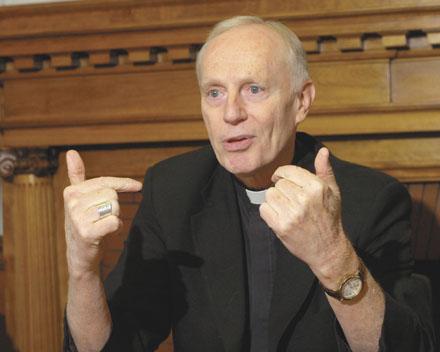By Tom Caprood
Troy Record
January 17, 2009
http://www.troyrecord.com/articles/2009/01/17/news/doc4972448badfa8306487741.txt
 |
Catholics throughout the Capital Region and beyond were given the news they had been waiting to receive for the past two years Saturday as the Roman Catholic Diocese of Albany disclosed the fate of local churches that will be closed or merged as part of the Called to BE Church initiative.
A total of 33 worship sites, just under 20 percent of the diocese’s churches, will be closed across the diocese over the next three years, according to a statement from Bishop Howard Hubbard.
Across the Capital District, a total of 17 churches are scheduled to close including six in Troy, two that will merge with other churches in Albany, two that will merge with other churches in Schenectady, three in Cohoes, three in Amsterdam, and one in Glens Falls.
“There’s no question that the closing of parishes is a difficult and painful process for the people of the parish, for which there is a great spiritual and emotional attachment. All of the people involved in this process empathize with the painful adjustments that will be required,” said Hubbard.
“In fact, my own home parish of St. Patrick’s in Troy will be closing – the church where I grew up, went to school, celebrated my first mass as a priest of the diocese, and buried my parents. But we as a church must acknowledge the social and demographic changes that require change, and remember our church must adapt, just as our ancestors’ church adapted to rapid changes in society throughout the 19th and 20th centuries.”
The initiative involved thousands of Catholics from across the diocese that, through the formation of 38 local planning groups made up of both parish leaders and parishioners, studied issues on neighborhood and regional levels across the 14 counties in which the diocese operates.
Their task was to find ways for the diocese to align its physical, financial, and personnel resources in a way that would serve the greatest number of Catholics while preserving the Church’s commitment to inner cities, the poor, the elderly, and other vulnerable populations.
The diocese decision to realign its parishes was driven by the fact that Catholics have been moving out of urban areas and into the suburbs in recent years. Most cities across the diocese have lost between 25 and 39 percent of their populations since 1960, excluding Saratoga Springs.
In a city such as Troy, with six urban churches and a total seating capacity of 3,200, combined weekend mass attendance has totaled roughly 1,300 – which is closer to the number of Catholics attending a single parish in Ballston Spa or Glenville.
While there were approximately 400 priests in the diocese in the 1960s, there are likely to be fewer than 100 serving the 132 parishes within the next five years, according to Hubbard.
After the parish closings and mergers, the number of parishes in urban areas will still outnumber those in the suburbs, as places such as Clifton Park, with a population of approximately 36,000, will have one parish, while Troy, with a population of roughly 47,000, will have seven parishes remaining.
“The Called to BE Church plan provides a blueprint for the most prudent use of the resources that have been entrusted to us and a clear statement of our continued commitment to meeting the spiritual and human needs of residents of our cities,” said Hubbard.
Similar parish planning initiatives have recently taken place in dioceses across the state as well as the northeast. Other nearby dioceses - such as Rochester, Syracuse, and Buffalo - have closed between 20 and 30 percent of their churches.
The full report on church closings will also be made available to the public on the diocese Web site at www.rcda.org.
Tom Caprood can be reached at 270-1278 or by e-mail at tcaprood@troyrecord.com.
Any original material on these pages is copyright © BishopAccountability.org 2004. Reproduce freely with attribution.